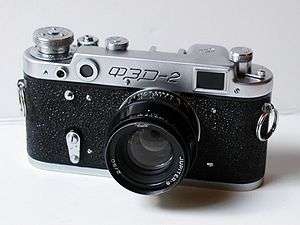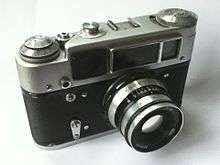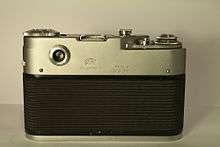FED (camera)
The FED is a Soviet rangefinder camera, mass-produced from 1934 until around 1996, and also the name of the factory that made it.




The factory emerged from the small workshops of the Children's labour commune named after Felix Edmundovich Dzerzhinsky (the acronym of which gave name to the factory and its products) in December 1927 in Kharkov (Soviet Ukraine, now Ukraine). Initially the factory was managed by the head of the commune Anton Makarenko and produced simple electrical machinery (drills).[1] In 1932, the new managing director of the factory, A.S. Bronevoy (Russian: А.С. Броневой), came up with the idea of producing a copy of the GermanLeica camera.[2]
Large-scale production began in 1934, and in the same year the factory was put under NKVD control and Makarenko was fired. Production continued until 1941, when German forces destroyed the factory, and resumed in 1946.
Until 1955 the factory made a huge number of cameras that resemble the Leica rather closely. They are often altered, given "Leica" markings and sold as Leicas. However the FED is cruder: for example the rangefinder cam is pointed and not circular as in Leicas. There are differences in the shutter-release buttons and viewfinder windows. The FED has a gap in the left side of the accessory shoe. Genuine Leicas have film-loading instructions on the inner surface of the baseplate and the screws on the front are always black; on the FED these screws are chrome-coloured. Unscrupulous rebranding of Soviet-made lenses also occurs, since Industar lenses are sometimes sold as Elmar lenses. Camera collectors have described the FED as interesting and often well made and effective so long as the buyer is not deceived into paying a premium for a counterfeit Leica camera.
From 1955 FED began to innovate, combining the rangefinder with the viewfinder in the FED 2 and all its successors. The FED-3 added slow shutter speeds and on the later version FED-3 (b) the film advance was changed from a thumbwheel to a lever. The FED 4 (1964–77) added a non-coupled selenium exposure meter. The FED 5 marked the end of the FED rangefinder family and was meant as a replacement for both the FED-3 and FED-4, which were in production at the time of its introduction. There were versions of the FED-5: the original FED-5 had an exposure meter, the FED-5B was a cheaper version without meter and the later FED-5C had reflected framelines showing field of view of 50mm lens and an exposure meter. All FED-5 cameras were delivered with an Industar I-61L/D lens. Production of FED rangefinder cameras ended in the mid 1990s (Fed-5 Serial Number 545446 was made on 28 February 1994; Fed's site claims that it was in fact 1997: "Start of serial production of vertical drive for control system of tanks. Production of all types of camera has stopped. 8,647,000 cameras were manufactured since the beginning.")
FED 1 collector information
The following types are nomenclature used by collectors since no FED 1 or Fedka camera was actually marked in this way. Brief descriptions are included to help with identification.
- 1a 1934–1935 SN 31- 6000 (some sights have been done on early style, read 1a, cameras up to number 6500. One has been at display on exhibit in Sweden with number 6454, but with all other specifications of an 1a) – some early production had poor galvanised finish rather than the normal satin chrome. Although early production quality was poor, these cameras are considered valuable owing to their rarity. For more details see the specification below.
- 1b 1935–1937 SN 6000 – 55000 – Some with the NKVD engraving "Peoples Commissariat of Internal Affairs", which was the new name for Stalin's secret police. Identifiable by the rectangular shape of the plate covering the front rangefinder; before it had been an irregular shape as on the Leica II.
- 1c 1937–1939 SN 55000 – 125000 – In 1937 a triangular cam-follower replaced the circular Leica-type cam follower and the speed dial was modified slightly to resemble the Leica II. 28 mm and 100 mm lenses were made available. A pocket tripod, self-timer, close-up lenses, darkroom equipment and filters appeared in this period.
- S 1938–1941 – Identical to 1c except that 2000 cameras were produced with a faster 1/1000" shutter speed. These cameras usually came equipped with a 50 mm f/2 copy of the Leitz Summer lens
- V (B) 1938 – Identical to 1c except with a faster 1/1000" second shutter speed and a slow-speed dial. This was a copy of the Leica IIIa camera and was equipped with a 50 mm f/2 copy of the Leitz Summer. Only 40 were made but a lot of fakes are in circulation to trap the unwary at camera fairs.
- 1d 1939–1941 (August) SN 125000 – 180000 – Identifiable by the centre retaining screw being off-centre and not concealed by the lens-mount flange. In addition, in 1939 Ukraine lost its nominal independence from Russia and camera engraving changed to highlight this from UkSSR to USSR.
- 1d 1942–1945 SN 174000 – 178000 – Around 4000 cameras manufactured in Berdsk from parts evacuated from the FED Ukraine factory before it was overrun by the Nazis.
- 1e SN 174000 – 180000 – Around 1000 manufactured in Berdsk in Siberia in the first few months of 1946 after hostilities ended, using parts made before the war. After returning to Kharkov the FED organization became independent of the NKVD. In addition the camera had a superior shutter assembly in a brass housing rather than the earlier aluminium design.
- T Engraved "Red Flag" in honour of new masters produced around SN 200000 and was fitted with a coated 50 mm f/3.5 Industar 10 lens
- 1f 1949–1953 SN 201800 – 400000 – New cursive-script Fed logo, flatter shutter button, coated lens engraved with what were then called the international f stops, f/4, f/5.6 and so on rather than the earlier f/4.5, f/6.3. Lens came with a bakelite rather than metal lens cap.
- 1949–1950 TSVVS – A remarkable camera taking the Contax bayonet mount and Leica body to produce a hybrid camera. Produced in very small numbers for presentation to senior officers in the Topographic Service of the army air force known as the TSVVS. A much modified Fed with brass body rather than aluminium fitted with a genuine Contax bayonet mount Carl Zeiss Sonnar f/1.5 or f/2 50 mm lens taken as spoils of war from the Zeiss factory at Jena. Again a lot of fakes in circulation. Also of interest is the Nikon rangefinder camera as it also had a Contax bayonet mount and Leica shutter. The true origin of the TSVVS camera is still unknown. Two major circulating theories is that the cameras has either been manufactured at Moscow's Almaz factory or it had been ordered for manufacture by the Soviets from East Germany (possibly Zeiss, but it is also not confirmed). This camera is probably the most mysterious in nature out of all Soviet cameras. An old belief that this camera was made by FED factory is disputed by the fact that the body is wholly made out of brass and it is different dimensions physically than the FED-1 cameras. (see forum discussions at USSRPhoto.com for more detailed arguments about it between various Soviet camera experts).
- 1g 1953–1955 SN 400000 – 800000 – Shutter speeds changed to 25th, 50th,100th instead of old Leica 20th, 30th, 40th, 60th. Threaded shutter button to accept standard shutter release instead of external thread Leica cable release which fitted over the button of earlier cameras. Mushroom type surround to shutter release.
FED 1 serial numbers and production numbers
- 1934 SN 000031 - 004000 - 4k
- 1935 SN 004001 - 016000 - 12k
- 1936 SN 016001 - 031000 - 15k
- 1937 SN 031001 - 053000 - 22k
- 1938 SN 053001 - 082000 - 29k
- 1939 SN 082001 - 116000 - 34k
- 1940 SN 116001 - 148000 - 32k
- 1941 SN 148001 - 175000 - 25k
- 1942 - 45 (World War 2) - see below
- 1946 SN 175001 - 176000 - 1k - see below
- 1947 SN 176001 - 186000 - 10k
- 1948 SN 186001 - 203000 - 13k
- 1949 SN 203001 - 221000 - 18k
- 1950 SN 221001 - 248000 - 27k
- 1951 SN 248001 - 289000 - 41k
- 1952 SN 289001 - 341000 - 53k
- 1953 SN 341001 - 424000 - 73k
- 1954 SN 424001 - 560000 - 136k
- 1955 SN 560001 - 700000 - 140k
- V (B) 1938 - 40
- S 1938 - 41 - 2k
- 1983 SN 104442 - 9377287 -150k
These serial numbers and production numbers are approximate. During World War II production was shifted to Siberia as the factory in Kharkov was overrun by Nazi German forces. During this period and immediately after the war some serial numbers between 174000 - 180000 were used on cameras built in Berdsk in Siberia, even in the first few months of 1946.
FED 1 lens type information
- 100 mm f/6.3 Fed lens first made in 1938. Supplied with viewfinder, less than 20,000 produced.
- 100 mm f/5.9 1937–1938 Fed lens, best used at f/6.3 or smaller aperture.
- 50 mm f/3.5 Industar-10 copy of the Leitz Elmar 50 mm f/3.5 manufactured 1934–1946 and fitted to most FED 1a, 1b, 1c and 1d. Old-style apertures f/4.5, f/6.3. From 1949 coated. From 1948 or 1949 new international f stops, f/4, f/5.6 and so on. A four-element design. The most produced lens and even fitted to the next generation Fed 2 camera and supplied to China for fitting on Chinese made Leica copies - Dai Lai "Popular" (Fed 1 or Zorki 1 copy), Shanghai and Chang Chiang "Yangtze River" (Fed 2 Copy).
- 50 mm f/2 Fed copy of Leitz Summer 1938–1941. A 6-element design with f/2 to f/18.
- 28 mm f/4.5 Fed wideangle lens 1938–1939. A 6-element design with f/4.5 to f/18. A viewfinder was produced in 1939 in very small quantities.
- A number of 50 mm f/3.5 macro lenses existed.
Some time probably between 1947 and 1949 when the first KMZ Fed-Zorki cameras were being assembled at the KMZ factory in Moscow with the collaboration of Fed engineers the copy of the Leitz Elmar 50 mm f/3.5 was replaced by a copy of the Tessar 50 mm f/3.5 in the same collapsible mount. This probably happened due to technical information taken as spoils of war from the Zeiss factory, which was in the Soviet-controlled zone of East Germany. The KMZ version of this Tessar lens was the Industar-22.
The original Industar-10 lens manufactured between 1934 and 1946 was a more or less exact copy of the Leitz Elmar 4-element lens that first appeared in 1924. This was based on the earlier 5-element Leitz Elmax which had been patented by 1920. The Industar-10, Elmar & Tessar had completely different focal lengths. The Industar-10s made between 1934 and 1948–1949 were 50 mm. Those manufactured after 1948–1949 based on the Zeiss Tessar were 52.4 mm. The later KMZ Industar-22 was 52.4 mm. The Carl Zeiss standard is 52.4, the same as the Sonnar (Jupiter 3 & 8) and later the Industar 26M, Industar-50, Industar-61—all used the standard CZ focal length. The last KMZ Industar made in quantity was the Type 50-2 for the Zenith, a small, flat unit in black with M42 thread, often sold as "Pancake Lens" to recent DSLR owners. This has two serious defects: The aperture ring sits inside the focus ring so cannot be stopped down after focussing, as is normal practice with manual lenses. The anti-reflection "economy"-coating is visibly poor inasmuch existent. Maybe only on a single surface. Although the images are sharp, they are typically overlaid by a fog filter. In contrast to the earlier 52.4 mm white-metal Industars with heavy blue coating, that are rarer, more expensive and often in heavily used condition.
FED (& GOMZ) started using coated lenses as late as 1949 to 1950 (Maizenberg Book), KMZ (1947 onwards - Zorki Zenit camera line) produced blue coated lenses making full use of the complete Carl Zeiss wartime technology. Only the latter years saw the Industar degraded to a mass item with production shortcuts affecting coating, as incidentally also with the last f/2.8/50 Tessars from the GDR.
Pre-World War 2 lenses have a slightly different lens-to-film register different from that of Leica lenses. Consequently, early Russian lenses should not be used on postwar cameras as they will not focus correctly, although results may be adequate when stopped down.
FED 1 technical specifications, 1934 (or Fedka)
- Copy of the Leica II.
- Manufactured 1934–1955 (spec as 1934 Fedka).
- About 700,000 made by the FED Machine Works Kharkov Ukraine (formerly the USSR).
- All were identical except for the six or seven different types of engraving.
- Lens is a copy of the collapsible Leitz Elmar Copy - FED or Industar-10 f/3.5/50 mm.
- Aperture settings: f/3.5, f/4.5, f/6.3, f/9, f/12.5, f/18 Lens is screw mount 39mm Leica-type.
- Shutter is cloth focal-plane.
- Shutter speeds: Z - 20th, 30th, 40th, 60th, 100th, 200th, 500th.
- Focusing: 1.25 M to infinity.
- Coupled range finder with a separate viewfinder.
- Film is standard 35mm.
- Loading via a removable bottom.
- Weight is approximately 630 g.
Notes
1948 or 1949 onwards Industar-10 lens with "international" f stops, f/3.5, f/4, f/5.6, f/8, f/11, f/16 1953 onwards Shutter speeds changed to 25th, 50th,100th, 200th 500th.
References
- https://web.archive.org/web/20080723190721/http://www.fed.com.ua/history.php
- Макаренко, А.С. Педагогическая поэма (PDF). p. 669. ISBN 5-88010-166-5.
External links
| Wikimedia Commons has media related to FED cameras. |
- Film about FED company history "To be the first!" (Rus)
- The FED company site (Rus)
- FED General Information (Rus)
- FED company history (Rus)
- Rangefinder cameras of the Soviet era
- Faraway, yet so close "Are Leica LTM lenses really compatible with Soviet LTM bodies?"
- Industar 26 and 61 Relubing
- rus-camera
- Exact Soviet Leica II copy the FED 1 or Fedka camera c. 1934 by Stephen Rothery
- Soviet development of Leica II concept the FED 2 c. 1955 by Stephen Rothery
- FED cameras Price Guide completed auction prices
- Zorki Survival Site by Jay Javier
- USSRPhoto.com Wiki catalog entries for the FED-1 cameras. Use left navigation to see other FED models
- Oscar Fricke: The Dzerzhinsky Commune: Birth of the Soviet 35 mm Camera Industry